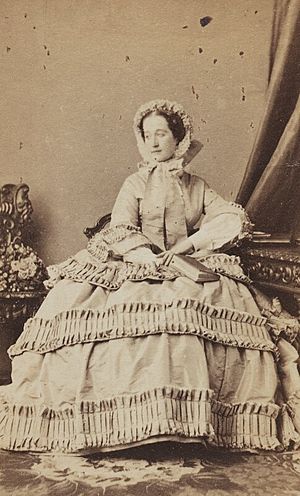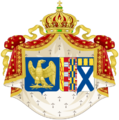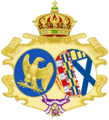Eugénie de Montijo facts for kids
Quick facts for kids Eugénie de Montijo |
|||||
|---|---|---|---|---|---|
| 19th Countess of Teba 16th Marquise of Ardales |
|||||

The Empress in 1862
|
|||||
| Empress consort of the French | |||||
| Tenure | 30 January 1853 – 4 September 1870 | ||||
| Born | 5 May 1826 Granada, Kingdom of Spain |
||||
| Died | 11 July 1920 (aged 94) Madrid, Kingdom of Spain |
||||
| Burial | St Michael's Abbey, Farnborough | ||||
| Spouse | |||||
| Issue | Louis-Napoléon, Prince Imperial | ||||
|
|||||
| House | Bonaparte (by marriage) | ||||
| Father | Cipriano de Palafox y Portocarrero, 8th Count of Montijo | ||||
| Mother | María Manuela Kirkpatrick de Grevignée | ||||
| Religion | Roman Catholic | ||||
| Signature | |||||
María Eugenia Ignacia Agustina de Palafox y Kirkpatrick (born May 5, 1826 – died July 11, 1920) was known as Eugénie de Montijo. She became the Empress of the French when she married Emperor Napoleon III on January 30, 1853. She was empress until her husband was removed from power on September 4, 1870.
Eugénie was born into a noble Spanish family. She received her education in France, Spain, and England. As Empress, she used her influence to support strong, traditional government policies. She also supported the Catholic faith. Her involvement in politics was often criticized by people at the time.
Napoleon III and Eugénie had one son, Louis-Napoléon, Prince Imperial (1856–1879). After the French Empire fell, the family lived in exile in England. Eugénie lived longer than both her husband and son. She spent the rest of her life honoring their memories and the memory of the Second French Empire.
Contents
Early Life and Education
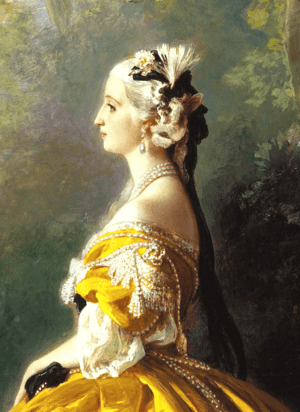
Eugénie was born in Granada, Spain. Her father was Don Cipriano de Palafox y Portocarrero, a Spanish nobleman. Her mother was María Manuela Enriqueta Kirkpatrick de Closbourn y de Grevigné, who had Scottish, Belgian, and Spanish roots. Eugénie's mother's father, William Kirkpatrick, was a United States consul in Spain.
Eugénie had an older sister named María Francisca, nicknamed "Paca." Paca inherited most of the family's noble titles. Before her marriage in 1853, Eugénie used the titles Countess of Teba or Countess of Montijo.
In 1834, Eugénie, her sister, and their mother left Madrid for Paris. They were trying to escape a cholera outbreak and dangers from a war. Eugénie had even seen a riot and murder outside their home the day before.
Eugénie, known as Eugénie de Montijo in France, was mostly educated in Paris. She attended the Convent of the Sacré Cœur from 1835 to 1836. She also went to the Gymnase Normal, Civil et Orthosomatique, which she liked because it focused on sports. A school report praised her love for athletic exercise.
In 1837, Eugénie and Paca briefly attended a boarding school in Bristol, England, to learn English. Eugénie was teased for her red hair and once tried to run away to India. She even got on a ship at Bristol docks.
Much of their education happened at home with English teachers. Family friends like the writers Prosper Mérimée and Henri Beyle also helped teach them.
In 1839, their father died in Madrid, and the girls returned to Spain. Eugénie grew into a strong and adventurous young woman. She loved horseriding and other sports. She also became very interested in politics. She supported the Bonapartist cause, which aimed to restore Napoleon's family to power.
Her mother was a popular hostess and introduced Eugénie to important people. These included Queen Isabel II and Prime Minister Ramón Narváez. Eugénie's mother was eager for her to marry. She took Eugénie on trips to Paris in 1849 and England in 1851 to find a husband.
Empress of the French
Marriage to Napoleon III
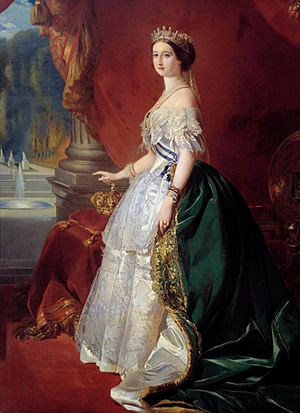
Eugénie first met Prince Louis Napoléon in 1849. He was then the president of the Second Republic. They met at a party at the Élysée Palace. When Napoleon asked her, "What is the road to your heart?", she famously replied, "Through the chapel, Sire."
On January 22, 1853, after becoming emperor, Napoleon III officially announced their engagement. He said he chose a woman he loved and respected. They had a civil wedding ceremony on January 29, 1853, at the Tuileries. A grander religious ceremony took place on January 30 at Notre Dame Cathedral.
Many people did not approve of the marriage. Some thought Eugénie was not from a high enough social class. However, the British newspaper The Times pointed out that the Bonapartes were marrying into one of Spain's most important noble families.
Eugénie found having children very difficult. She had a miscarriage in 1853, which was a hard experience for her. On March 16, 1856, after a difficult two-day labor, she gave birth to their only son. He was named Napoléon Eugène Louis Jean Joseph Bonaparte and was called the Prince Imperial.
Public Life and Influence
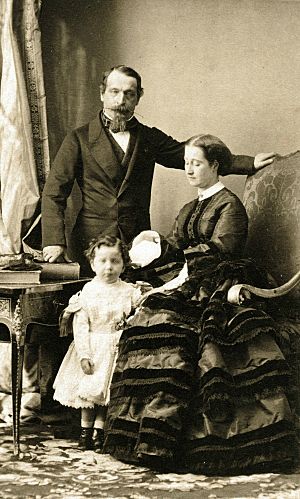
Eugénie carried out her duties as empress very well. She hosted guests and attended balls, opera, and theater with the emperor. After her marriage, she had a group of ladies-in-waiting. These were mostly friends she knew before becoming empress.
She traveled to Egypt to open the Suez Canal in 1869. She also officially represented her husband when he traveled outside France. In 1860, she visited Algiers with Napoleon. She strongly supported equal rights for women. She pushed for the first woman to receive a university degree in France. She also tried to get the writer George Sand elected as the first female member of the French Academy, but she was not successful.
Her husband often asked for her advice on important matters. She acted as regent, meaning she ruled in his place, when he was away in 1859, 1865, and 1870. She even led meetings of the Council of Ministers for a short time in 1866. As a Catholic and a traditional thinker, her influence often balanced the emperor's more liberal ideas. She strongly believed in monarchy (rule by kings and queens). She often showed support for other European royal families who were facing problems.
She was a strong supporter of the Pope's power in Italy. She tried to stop her husband from recognizing the new Kingdom of Italy. This new kingdom was formed after Sardinia took over other Italian lands. She also wanted French soldiers to stay in Rome to protect the Pope. Her opposition to Italian unification made her an enemy of Victor Emmanuel II of Italy.
Some people blamed her for the failure of the French intervention in Mexico. This event led to the death of Emperor Maximilian I of Mexico. However, other historians disagree about how much influence she truly had.
In 1868, Empress Eugénie visited the Dolmabahçe Palace in Constantinople. This was the home of Pertevniyal Sultan, the mother of the Ottoman Sultan. According to one story, Pertevniyal was upset by Eugénie's behavior. She reportedly slapped the empress on the stomach or face. This almost caused a major international problem.
Influence on Fashion and Arts
The Empress Eugénie was very influential in fashion. She was "perhaps the last Royal personage to have a direct and immediate influence on fashion." She set the trends for clothing at a time when Paris was famous for its luxury goods. Dresses, colors, and hairstyles "à l'impératrice" (in the empress's style) were copied all over Europe and America.
She was known for her large crinoline skirts. She also changed her outfits many times a day, with different dresses for morning, afternoon, evening, and night. She never wore the same gown twice. She had a huge wardrobe and sold her old clothes each year for charity. Her favorite designer, Charles Frederick Worth, became the official dressmaker to the court in 1869. In the late 1860s, she helped change fashion by moving away from crinolines to slimmer dresses with fabric gathered at the back over a bustle.
Eugénie's influence also extended to home decoration. She greatly admired Marie Antoinette, a former French queen. She decorated her palaces in the styles of the 18th century, known as Louis XV and Louis XVI styles. This led to a popular trend called "Style Louis XVI Impératrice."
In 1863, the Empress created a museum of Asian art at the Palace of Fontainebleau. It was called the musée Chinois (Chinese Museum). She carefully arranged the displays. The museum included gifts from an embassy from Siam in 1860. It also had items taken from the Old Summer Palace near Beijing by French soldiers during the Second Opium War. General Charles Cousin-Montauban, Comte de Palikao sent these items to Eugénie as a gift. The collection has about 800 objects, with 300 from the Summer Palace.
Biarritz: The Imperial Summer Home
In 1854, Emperor Napoleon III and Eugénie bought land in Biarritz, a town in France. They built a summer home there called the Villa Eugénie, which is now the Hôtel du Palais. Napoleon III chose this location near Spain so Eugénie would not miss her home country. The presence of the imperial couple made Biarritz a famous place. Other European royals, like Queen Victoria of Britain, visited there.
Role in the Franco-Prussian War
Empress Eugénie did not like Prussia or its leader, Otto von Bismarck. She felt that France's power was threatened. She believed that winning a war against Prussia would secure her son's future as ruler. Some sources say she often stated that "Catholic France could not support the neighborhood of a great Protestant power."
In 1870, a diplomatic crisis started over a Prussian candidate for the Spanish throne. This led to the Franco-Prussian War. Eugénie was key in pushing her husband to support what she called "her war." She once told her husband that their son would "never reign unless we repair the misfortunes of Sadowa" (referring to a previous Prussian victory).
After the war began, Eugénie stayed in Paris as Regent. Napoleon III and their son went to join the troops. When news of French defeats reached Paris on August 7, people were shocked. The prime minister and army chief resigned. Eugénie then chose a new government.
Napoleon III thought about returning to Paris, but Eugénie telegraphed him. She told him not to come back unless he wanted to cause a terrible revolution. She said people would think he was fleeing danger. The emperor stayed with the army but sent his son back to Paris. With Eugénie leading the country and a new commander for the army, the emperor had no real role.
The French army was defeated, and Napoleon III surrendered to the Prussians at the Battle of Sedan. News of this reached Paris on September 3. When Eugénie heard that the emperor and army were prisoners, she was very upset. She shouted that an emperor does not surrender and should have died.
Later, angry crowds gathered near the Tuileries Palace. Eugénie secretly left with a friend and found safety with her American dentist, Thomas W. Evans. He took her to Deauville. From there, on September 7, she took a British official's yacht to England. Meanwhile, on September 4, a group of politicians declared the return of the Republic.
From September 5, 1870, to March 19, 1871, Napoleon III was held in a comfortable prison in Germany. Eugénie traveled secretly to Germany to visit him.
Life After the Franco-Prussian War
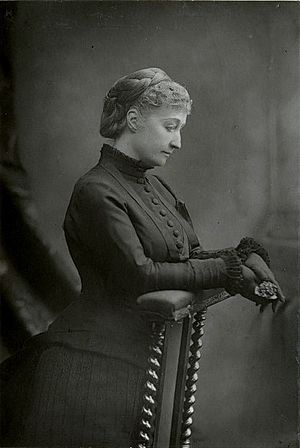
After France's defeat in the Franco-Prussian War, the Second Empire ended. Eugénie and her husband found a permanent home in England. They settled at Camden Place in Chislehurst, Kent. Her husband, Napoleon III, died in 1873.
Her son died in 1879 while fighting in the Zulu War in South Africa. Eugénie visited the place where he died on the first anniversary of his death. After her son's death and becoming a widow, she tried to unite different royalist groups in France. She wanted them to oppose the new French Republic. She even suggested that her son be adopted by the Count of Chambord, another claimant to the French throne, but this idea was rejected.
In 1885, she moved to Farnborough, Hampshire. She also had a villa built for her in the south of France, called Villa Cyrnos. She lived there in retirement and stayed out of politics. Her house in Farnborough is now a Catholic girls' school called Farnborough Hill.
After her husband and son died, her health began to decline. She spent some time at Osborne House on the Isle of Wight. Her doctor suggested she visit Bournemouth, which was known as a health resort.
Her family's friendly relationship with the United Kingdom was remembered in 1887. She became the godmother of Victoria Eugenie of Battenberg. Victoria Eugenie later became queen of Spain. Eugénie was also close to Empress Alexandra Feodorovna of Russia. Alexandra and Emperor Nicholas II visited Eugénie in 1909.
When World War I started, she gave her steam yacht, Thistle, to the British Navy. She also paid for a military hospital at Farnborough Hill. She made large donations to French hospitals. For her efforts, she received the Order of the British Empire (GBE) in 1919.
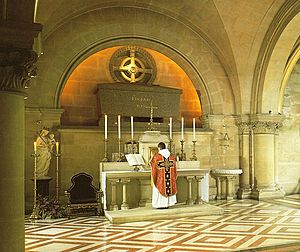
The former empress died in July 1920 at the age of 94. She passed away during a visit to her relative, the 17th Duke of Alba, in Madrid, Spain. She is buried in the Imperial Crypt at St Michael's Abbey, Farnborough, with her husband and son.
After World War I, Eugénie lived long enough to see other European monarchies fall apart. These included the monarchies of Russia, Germany, and Austria-Hungary. She left her belongings to various relatives. Her Spanish properties went to her sister Paca's grandsons. Her house in Farnborough and all its collections went to her son's heir, Prince Victor Bonaparte. Her Villa Cyrnos went to his sister, Princess Laetitia of Aosta. Her money was divided among these relatives. She also left 100,000 francs to help rebuild the Reims Cathedral.
Legacy and Recognition
Empress Eugénie has been honored in space. The asteroid 45 Eugenia was named after her. Its moon, Petit-Prince, was named after her son, the Prince Imperial.
She had a large and unique collection of jewelry. Much of it later belonged to a Brazilian socialite named Aimée de Heeren. De Heeren also collected jewelry and admired the empress. Both were known as "Queens of Biarritz" because they spent summers there. Eugénie was impressed by the elegant jewelry of her time. In 1858, she opened a jewelry shop in the Royal Palace called Royale Collections.
She was also honored by the scientist John Gould. He gave the white-headed fruit dove the scientific name Ptilinopus eugeniae.
Honors Received
- 475th Dame of the Royal Order of Queen Maria Luisa of Spain, March 6, 1853
- Dame of the Order of Saint Isabel of Portugal, 1854
- Grand Cross of the Order of Saint Charles of Mexico, April 10, 1865
- Honorary Dame Grand Cross of the Order of the British Empire, 1919
Film Portrayals
- In Suez (1938), Loretta Young played her as a love interest.
- In Juarez (1939), Gale Sondergaard played her. She was shown as a strong empress who helped put Archduke Maximilian on the throne of Mexico.
- In Violetas Imperiales (1932, 1952): Eugénie de Montijo (played by Simone Valère) asks a gypsy girl to read her fortune. Encouraged by the prediction that she will become a queen, Eugénie goes to Paris.
- In The Song of Bernadette (1943), Patricia Morison played her. In the film, she believes the waters of Lourdes cured her son.
- In The Diving Bell and the Butterfly (2007), Emma de Caunes played her in a dream scene.
- In the miniseries Sisi (2009), she was played by Hungarian actress Andrea Osvart.
Images for kids
-
Coat of Arms as dame of the Order of Queen María Luísa (1853–1920)
See also
 In Spanish: Eugenia de Montijo para niños
In Spanish: Eugenia de Montijo para niños



